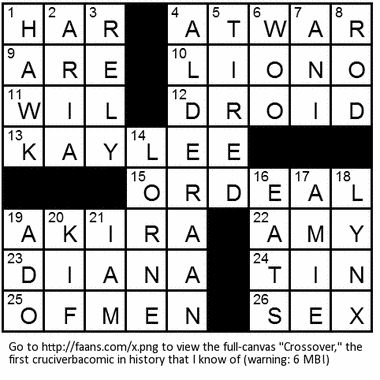Here are the rules for doing a cruciverbacomic, in case you’d like to try this exercise yourself.
1. Start with a filled-in crossword grid. You can make your own like I did, or take one from another source, as long as you give credit. The grid should follow the standard New York Times rules: no uncrossed squares, no two-letter words, and no horribly obscure words or words you just made up. Rotational symmetry’s also desirable but not an absolute requirement. (Note: you can rework this grid later if you need to, but it should continue to obey these rules.)
2. Your comics story should consist of square panels, each of them corresponding to one square within the grid.
3. Panels that correspond to black squares should be silent, meaning no dialogue balloons, thought balloons, sound effects or “commentary effects” like “EPIC FAIL.” (I’ve borrowed “commentary effects” from Internet imagery like I Can Has Cheezburger?, though they also have some antecedent in the Japanese tradition of making “sound effects” for things that aren’t actually sounds, and I’m far from the only American comics person to use them.)
Depicting letters in a silent panel is acceptable if the letters would be visible in a film, like a stop sign or a signature on a check. The black-square panels should also be darkened in some way that makes their status clear when the comics grid is completed. (I opted for heavy borders.)
4. In the other panels, the first letter of a dialogue balloon, thought balloon, sound effect or commentary effect should correspond to the letter inside the corresponding square.
5. Each word in the crossword, whether entered across or down, should be a part of the dialogue balloons, thought balloons, sound effects or commentary effects in a comics panel that corresponds to one of the word’s squares.
6. The comic should be able to “pass” as a regular comics story with a narrative thread, not just an assortment of unconnected occurrences.
There are no other restrictions on size, genre or content. Have fun!

